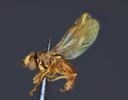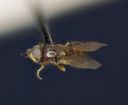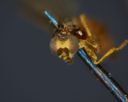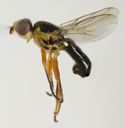Frit Flies
Chloropidae
Classification
- Phylum: Arthropoda
- Subphylum: Hexapoda
- Class: Insecta
- Order: Diptera
- Superfamily: Carnoidea
- Family: Chloropidae
Pronunciation
How to pronounce Chloropidae: /ˌklɔːrəˈpɪdiː/
These audio files are automatically generated. While they are not always 100% accurate, they are a good starting point.
Images






Summary
The Chloropidae family encompasses small, shiny flies commonly referred to as frit flies or grass flies. They are found worldwide and are primarily phytophagous, with several species having notable economic impact as pests of cereals. Some species also have medical significance due to their role in disease transmission.
Physical Characteristics
Chloropidae are minute to small (1.0 to 4.0 mm), rarely medium-sized (6.0 to 9.0 and 12 mm) flies. They are either black, gray, yellow, or greenish. The mesonotum often has a pattern of three to five dark longitudinal stripes against a light background. The head is trapezoidal or triangular in profile with weakly developed bristles. The vertical triangle can be large, glossy, or matte. Wing structure varies among species, with developed wings or reduced to small disks.
Identification Tips
Look for small, shiny flies that are usually yellow or black, with a distinctive ocellar triangle on the head. The absence of significant hairiness can also be an identifying feature.
Habitat
Common in meadows and grassy areas, though found in a variety of habitats.
Distribution
Approximately 280 species in ~55 genera in specific areas, close to 3,000 species in ~200 genera worldwide.
Diet
Larvae are mainly phytophagous, feeding on the grasses of Poaceae, Cyperaceae, and Typhaceae. Adult feeding habits vary; some feed on plant juices.
Life Cycle
Most species hibernate as larvae, with some hibernating as adults. They undergo complete metamorphosis from egg to larva, pupa, and adult.
Reproduction
Details on specific reproductive methods are not provided, but like most flies, they generally lay eggs that hatch into larvae.
Predators
Natural predators are not specified; however, larvae may be found in associations with other insects and can be preyed upon in rare instances.
Ecosystem Role
Larvae play a role in plant damage and can be significant pests of cereal crops. Some species also act as saprophages, scavengers, or predators.
Economic Impact
Some species are important agricultural pests, particularly those that damage grain cereals such as rice.
Cultural Significance
Certain species are known to cause serious irritation and infection due to their attraction to animal secretions, necessitating protective measures for livestock and humans in affected areas.
Health Concerns
Some species act as vectors for bacterial infections, such as yaws and pinkeye, and can be irritants. Potential transmitters of viruses like vesicular stomatitis and some species may cause myiasis in their hosts.
Collecting Methods
- Sweep netting in grassy areas
- Light traps
Preservation Methods
- Ethanol preservation
- Pinned specimens
Evolution
There are scant records of Chloropidae in amber deposits from the Eocene and Oligocene periods; some material may date back to the Cretaceous or earlier.
Similar Taxa
Misconceptions
Chloropidae are often confused with other small flies but can be distinguished by their shiny appearance and lack of significant hairiness.
Tags
- Chloropidae
- Frit Flies
- Grass Flies
- Pest Management
- Entomology